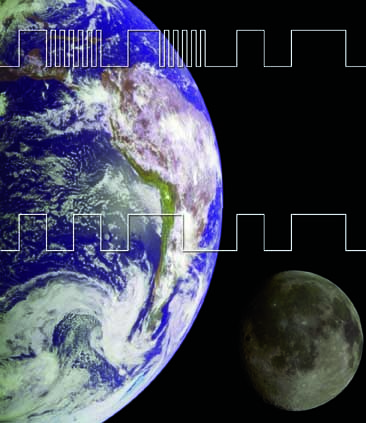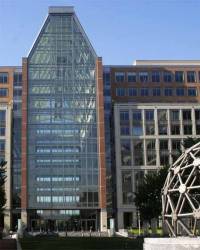Download the list of GNSS-related signal patents (PDF)
Download the list of GNSS-related signal patents (PDF)
The U.S. Patent and Trademark Office (USPTO) is weeks away from approving a controversial British patent that could force American consumers to pay more for GPS navigation devices and even affect the operations of the American military.
The patent is one of dozens filed around the world by the British defense establishment asserting ownership of technology developed jointly by the United States and the European Union (EU). The patents lay claim to a signal structure crafted by American and European experts to make Europe’s still-emerging Galileo satellite navigation system interoperable with GPS and improve service for users of both systems.
Over the last year Ploughshare Innovations, a wholly owned subsidiary of the research and development division of the British Ministry of Defense has been contacting receiver manufacturers in North America and Europe asserting intellectual property rights to the signal structure and, in some instances, requesting royalties. In one case, said a source who asked not to be named, Ploughshare was seeking a percentage of receiver revenues.
Should the U.K. be able to enforce the patents, buyers of receivers that use the signal will likely pay more. That includes U.S. agencies such as the Department of Interior and the Federal Aviation Administration, which use GPS for mapping and air traffic control.
“Anybody that uses the new signal . . . could potentially be impacted,” said Tony Russo, director of the Positioning, Navigation, and Timing National Coordination Office. “If there is a determination that their patent applies to our signal, then there is a potential impact.”
Even though it has its own dedicated military signals, the Department of Defense could also wind up with a bigger bill. The military “acquires GPS receiver devices for non-combat purposes that make use of civil GPS signals,” said an Air Force official. “A patent on such signals and receivers — if deemed legitimate — could potentially impact the Department of Defense.”
Though the U.S. government has apparently not been asked to pay royalties at this point, Ploughshare has contacted the maker of the new GPS III satellite, according to the official. The GPS III satellites will be the first U.S. spacecraft to transmit the civil signal, L1C, based on the common signal design. Lockheed Martin, the prime contractor for the GPS III satellite, declined to comment on the issue.
Receiver manufacturers, however, have been vocal about the patent claims. Companies on both sides of the Atlantic have complained to their governments and prodded their professional associations to speak up, sources have told Inside GNSS.
“We are taking this seriously,” said one source in the commercial sector, who asked not to be named because of the sensitivity of the issue. “We are taking this up with anyone who can help with this – to come to a proper solution.”
Exactly what that solution may be remains to be seen. U.S. officials have been studying the issue and will meet in June to decide on a course of action. “We’ve collected the information, but we haven’t got an approved position yet,” said Russo.
According to sources familiar with the controversy the first step appears to be an agency-to-agency conversation between U.S. and British defense officials. The U.S. State Department is also involved, and discussions have taken place between diplomatic representatives of the two nations. The British delegation in Washington did not response to calls about the issue. The U.K.’s Defence Science and Technology Laboratory (DSTL) — the owner of Ploughshare Innovations — declined to comment for this article.
Should efforts to negotiate a solution fail, U.S. officials can challenge the patents in court. In the process, sources tell Inside GNSS, they may assert that Americans actually invented the technology.
It Was a Cordial Relationship
The signal structure emerged from the work of the Galileo Signal Task Force of the European Commission. The group was created as part of the Agreement on the promotion, provision and use of Galileo and GPS satellite-based navigation systems and related applications — a landmark 2004 accord formalizing cooperation on satellite navigation between the United States and more than two dozen European countries, including the U.K.
The frequency structure developed by the task force will be used by GPS’s new L1C civil signal and Galileo’s E1 signal for its Open Service. Called MBOC — short for multiplex binary offset carrier — the signal structure laces a BOC(1,1) signal with an occasional BOC (6,1) signal to work around the limitations created by spectrum crowding and reduce the multipath errors created when signals bounce off reflective surfaces.
Experts from both the United States and the European Union participated, and the cooperative nature of the Task Force seemed, at the time, to mark a turning point in a sometimes sharp-elbowed U.S.–EU relationship on GNSS issues. The revelation of the patents over the last eight months has turned the clock back and is likely, said sources familiar with the issue, to cool future collaboration.
The U.S. government may hesitate to contribute to meetings or sit down with its European partners, said one source, “if someone in the meeting is going to run out and patent whatever we talk about.”
In fact, U.S. officials are so angry about the patents that dropping the MBOC signal structure has emerged as an option. That would probably require Lockheed Martin to modify the signal generators that have been designed for GPS III satellites.
Staking a Claim
While the U.S. representatives may not have been expecting patents to emerge from the task force, someone was certainly thinking about it — the agreement forming the task force has a specific provision that covers intellectual property. “Nothing in this Agreement,” states Article 9, “is intended to affect intellectual property rights related to global satellite-based navigation and timing signals, services or goods.”
“Unfortunately, what happens is people read that to say that, by virtue of this agreement, we are not claiming any intellectual property,” said Vincent Pollmeier, a patent attorney and chief technology counsel with the Los Angeles firm of Quinn Emanuel. “A lot of times people don’t realize what that really means is that anybody who has any intellectual property rights, the fact that we are all teaming up together, doesn’t prevent them from enforcing them.”
Two Prolific Families
The patents at issue fall into two groups — actually two families of patents, each springing from one of two filings with different priority dates: in the case of the two U.K. patents, one is September 1, 2003, which is before the task force was formed, and the other is June 20, 2006 — well after the group began meeting.
The priority date is very important in patent disputes because they are generally what patent examiners use to help determine when something was invented and, most importantly, who invented it first. All subsequent patents in the same family, including those filed in other countries, rely on the priority date of the initial patent to establish their legal place in the patent-rights pecking order.
In many other ways the two families are similar. Ownership of both patent families has been assigned to the British Minister of Defence and both list as inventors Tony (A. R.) Pratt and John I. R. Owen. Pratt is a consultant to the British government in the development of the Galileo satellite system as well as a member of the Inside GNSS Editorial Advisory Council. Owen is leader of navigation systems, Air Systems Department, and a senior fellow at DSTL.
Both men were members of the signal task force, a fact that has raised questions about the actual source of the invention, the patenting of MBOC and, by extension, the validity of the 2006 patent. Neither Pratt nor Owen responded to a request for comment for this article.
The 2003 patent is for “Modulation of signals for a Satellite Navigation System” There are five U.S patent applications in this family, said Pollmeier. Two are ready for examination and one has been given a non-final rejection. As of March of this year, two continuation applications have also been filed though they have yet to be published. These, as the name implies are filed to keep alive the conversation with the patent office as discussions continue or changes are made.
The attention of U.S. officials appears to have been largely focused on the earlier family and an opportunity to challenge the patent in Europe Union and, by extension, in the U.K.
The United States has until November 2 to challenge the 2003 patent before the European Patent Office (EPO), said lawyers Ingo Baumann of the space industry law firm BHO Legal and Ingolf Bode of the patent law firm Bode Meitinger, both in Germany.
“The decision of the EPO on the opposition procedure has effect for all 28 contracting states, including UK, and would be the easiest way to challenge the European Patent,” they said.
See the sidebar, “A European Perspective on Patent Dispute over GPS-Galileo Civil Signal,” for additional comments from Baumann and Bode.
The 2006 patent is for “Signals, system, method and apparatus.” A single U.S. patent has been filed in this family — and it is on the verge of being granted.
The USPTO file indicates that a “Notice of Allowance and Fees Due” has been issued for the U.S application in this patent family. This means that, “pending the payment of any fees the patent will issue,” said Pollmeier. “They sent out the Notice of Allowance on March 26; so, this patent is probably on track to be issued in the next few weeks.”
Federal officials are aware of the patent’s imminent issuance and have talked to the USPTO and the Departments of Justice and State, said Russo. As of press time, however, no action has been taken.
The actual effect that issuance of the patent would have remains unclear, although companies with GPS businesses may be faced with a decision on paying royalties before the new signal is even available. Though the L1C signal will not be broadcast until at least 2015 when the first GPS III satellite is launched, companies are already marketing L1C-capable receivers (though those devices may require some sort of a software or hardware upgrade.)
“Generally when a patent issues it entitles you to two things,” said George Medlock, a partner in the intellectual property litigation group in the Atlanta, Georgia, offices of the law firm of Alston & Bird, LLP. “One is the right to seek monetary damages on that patent and the other thing is to get an injunction – to stop someone from using your invention that is covered by the patent.”
Should willful infringement be shown – that is should someone knowingly infringe – then those damages could triple. Sometimes parties will give notice regarding their patent right before it issues or right after it issues as a way to establish this, Medlock said.
Still unclear, however, is whether the contact with Lockheed Martin or the letters sent to European manufacturers — which, a source said, asserted Ploughshares patents but did not immediately ask for royalties— are part of an effort to establish willful infringement or push for an injunction.
There is a legal standard of notice for infringement that the letters would have to meet, noted Pollmeier. “It is not an easy (case) to bring, an easy standard, to meet,” said Medlock.
Options
The game is definitively afoot, however, and the United States is preparing to respond. There are several grounds on which the U.S. might try to challenge the patents, suggested Pollmeier, who like Medlock, Baumann and Bode is not involved in the case.
For example, in the case of the 2006-family patent application the USPTO examiner ignored a letter submitted February 7 regarding two MITRE Corporation patents on “Time-Multiplexed Binary Offset Carrier Signaling and Processing” that were “expressly abandoned . . . to allow universal free access to the invention.” These patents could have been considered evidence of an earlier invention – something that the examiner could point to as a reason to deny the applications.
The letter was not considered, however, because it was not correctly filed, according to Pollmeier.
“Because that submission didn’t meet the requirements of the regulations of the U.S. that submission of the preexisting prior art was ignored by the [patent] examiner,” he said. “So none of that art has been considered in whether to allow the patent.” But that does mean, Pollmeier added, “that someone could potentially challenge the patent after it issues on the basis of that art.”
The very existence of the 2006 family of patents also creates a question about the applicability of the 2003 patent family to MBOC, Pollmeier suggested.
“They are going to have to distinguish between what the 2006 family claims and describes and what the 2003 patent claims and describes or the 2003 patents will be prior art on the 2006 family,” he said. ‘That issue has apparently not come up in the prosecution. At least the U.S. patent office apparently doesn’t see those as related – in claiming the same thing.”
Pollmeier, who was involved in the testing and early utilization of the prototype GPS satellites and became particularly familiar with signal structures during 12 years as principal system engineer at NASA’s Jet Propulsion Lab, said that the 2006 patent appears more applicable to the MBOC signal than the 2003 patent — an opinion broadly expressed by several expert sources who spoke to Inside GNSS.
But by granting the 2006-family application in the United States the U.S. patent examiner has effectively determined that the 2003-family patent does not cover the same invention as the 2006-family patent. If it did it would be prior art and the 2006-family patent would not have been granted.
If the 2006 patent is more applicable to MBOC — and the 2003 and 2006 patents are not about the same technology, “that would suggest that, if the 2006 family of patents is specifically directed at the MBOC signal, then the 2003 family of patents are not as clearly applicable to the present MBOC signal,” Pollmeier said.
“Someone has decided that those 2003 patents actually don’t claim the same invention [as the 2006} and don’t disclose enough to invalidate the subsequent patents,” he explained. That must have been the view of the British Ministry of Defence as well, he added, or they would not have filed the second patent application.
“The filing of the subsequent set of patents could, in fact, affect how a U.S. court interprets the earlier set of patents.”
Pollmeier had a different perspective on the 2006 patent family. The timing of the filing of the patent — after the launch of the task force — will leave it open to challenge. “There will very likely be a legal challenges to the validity of the 2006 family of patents,” Pollmeier said, “and the applicability of the 2003 family of patents.”
A list of patents in the two families compiled by Pollmeier can downloaded here:
Download list of 2003 GNSS signal patents (81 K PDF)
Ambushed?
Bode pointed out that, though the initial patent was filed in 2003 in the U.K. the members of the task force could not have known about it because it was not published until 2005 and therefore unavailable to people outside of the inventors’ circle.
This would seem to fit the description of an ambush patent as described in Patent Thickets, a November 2011 publication published by the U.K.’s own Intellectual Property Office:
“Historically, a source of conflict has been the late disclosure of patents which are considered to be relevant to a standard that has already been developed, and may be already used in industry, or has been substantially negotiated. The discovery of further relevant patents is often known as a ‘patent ambush’ and at a late stage it is not possible if they or cost-effective to renegotiate the contract.”
Pollmeier suggested that, had the 2003 patent been disclosed at the time the task force was meeting, “you would have seen a very different reaction and you probably wouldn’t have seen the adoption of the standard — or you would have seen some other change in the intellectual property practice.”
“There are certainly those who would call this an ambush patent,” he said.






